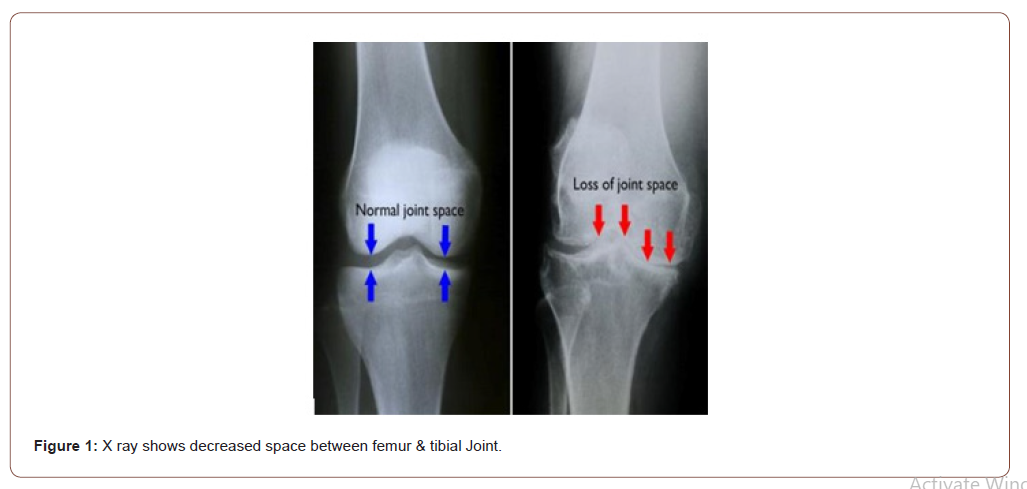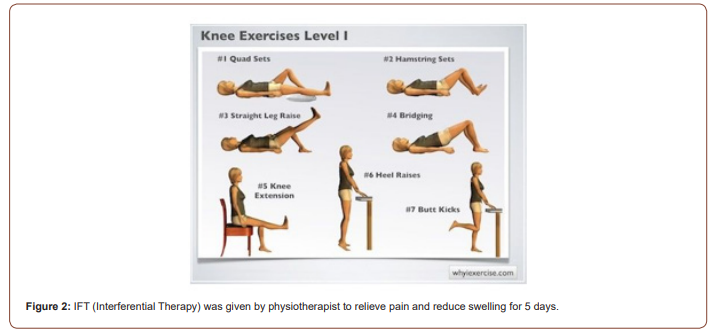Authored by Pallavi*,
Abstract
Knee osteoarthritis (OA), also known as degenerative joint disease of the knee, is typically the result of wear and tear and progressive loss of articular cartilage. Age, weight and gender are the predisposing risk factors and symptoms are swelling, pain and stiffness at knee joint. We here present a case of 43-year-old housewife reported with pain, swelling and stiffness at right knee on 5 May 2021 was taken to nearby orthopedician. After physical examination and radiological investigation, she was diagnosed with knee osteoarthritis. He treated her with some analgesics and anti-inflammatory drugs and suggested to take physical therapy and counselled for weight reduction. In a follow up visit she had reduced her weight by 3 kgs in a month’s time and was doing fine. We infer that weight of an individual plays an important role in the incidence of knee osteoarthritis.
Background
Knee osteoarthritis (OA) is the most common joint disease. Almost everyone will eventually develop some degree of osteoarthritis. The most common cause of osteoarthritis of the knee is age. Some factors increase the risk of developing significant arthritis at an earlier age. Weight is one such variable that increases pressure on all the joints, especially the knees. a 5-unit increase in body mass index was associated with a 35 per cent increased risk of knee OA [1]. Women ages 55 and older are more likely than men to develop osteoarthritis of the knee. We report a case in a relatively young women of 43 years but obese lady and with no familial history, in contradiction to known factors and managed by standard practices of weight reduction, physiotherapy and NSAIDs in the initial few days for pain relief.
Introduction
Knee osteoarthritis (OA) is the most common joint disease, in which the articular cartilage present between the femur and tibial bone joint will damaged. It is the second most common rheumatologic problem and the most frequent joint disease with a prevalence of 22% to 39% in India [2] OA is more common in persons aged 55 years and above, Obesity and gender i.e., more among women than men, are higher risk factors and the prevalence increases dramatically with age Osteoarthritis is a progressive disease that may eventually lead to disability. Common clinical symptoms include, a) Knee pain that is gradual in onset and worse with activity, b) Knee stiffness and swelling, c) Pain after prolonged sitting or resting. However, symptoms become severe, more frequent over time. The rate of progression also varies for everyone.
Case Presentation
On 5th May 2021, a short obese lady of 43 years, consulted a private Orthopaedic specialist with complaints sweeling, pain and stiffness in the Right knee joint and restricted movements. The pain and stiffness were first noticed three months ago. The pain used to aggravate after long walks, staring up and down, sitting on ground for long time and easing factor was rest. At night and morning, the pain was severe. Day by day her pain was increased and forced her to seek care.
Orthopedician Findings
Physical examination like palpation for tenderness and warmth was positive. There was swelling, touch elicited tenderness, warmth and restricted movements
Weight:75kgs
Height: 151cm
Built: short and obese.
BMI= 32.9kg/m2- Obese class 1
Investigations: x-ray; right knee -AP and lateral view (Figure 1)

Diagnosis: Based on history, physical examination findings and x ray diagnosed as having Rt. Knee osteoarthritis.
Treatment: For immediate relief she was put on following drugs.
Pharmacological Therapy
1.Tab Spade Ap- pain relieving medicine (containing Aceclofenac 100mg, Paracetamol 325mg and serrati peptidase 15mg) daily two times morning and night after food for 5 days.
2.Tab Calcium 1.5g- daily two times morning and evening after food for 10 days
3.Tab Trueceprol- Oxaceprol anti-inflammatory drug (containing Oxaceprol 600mg) daily two times morning and night after food for 5 days.
4.Tab Razo d- proton-pump inhibitors. It works by decreasing the amount of acid made in the stomach (containing Pantoprazole 40mg) for 5 days
5.Inj dynapar-pain killer (containing diclofenac 75mg/ml) given at hospital
Orthopaedician advised her for losing weight and regular exercise and counselled to avoid activities that put load on her knee joint such as squatting, ascending, and descending of stairs, jumping, running.
Physical therapy
A schedule of physiotherapy was recommended and initially done under the guidance of physiotherapist with the goal of increasing the range of movements and flexibility that could ease her pain. Muscle strengthening exercise such as Quad sets, Hamstring sets, Straight leg raises, Bridging, Knee extension, Heel raises, Butt kicks was suggested IFT (INTERFERENTIAL THERAPY) was given by physiotherapist to relieve pain, and to reduce swelling for 5 days.
Bracing
Knee unloader was prescribed to relieve pain and for knee support.
Follow up tip
• 1st follow-up: Followed up after 5 days, of therapy, the pain and sweeling had subsided after 2 days and was almost negligible on the day od visit after completing IFT therapy and medicine course. She was doing well after stopping IFT and medications there was no pain and sweeling. Was advised to continue with her knee strengthening exercise and wearing knee brace while working and standing for long hours.
• After One Month: Followed after one month she was doing fine now and had reduced 3 kgs of weight and continued with her weight loss efforts.

Discussion
Osteoarthritis (OA) a common disease of aged population and one of the leading causes of disability. Incidence of knee OA is rising by increasing average age of general population. Age, weight, trauma to joint due to repetition of movements in particular squatting and kneeling are common risk factors of knee OA [3]. In our case though age was not in favour but her weight was the main reason for the condition as Obesity can predispose patients to suffer from knee OA [4].
A typical management starts with topical and oral NSAIDs to reduce the pain, tenderness, rigidity and improve movements, as was done our case. This should be quickly followed as soon as the acute pain is reduced with non-pharmacological therapies the longterm solution of treatment for knee OA. Our case was also advised on the same line for Weight management that played an important role in symptom relief and help weight. body weight influences the severity of OA; obese individuals have significantly more severe joint degeneration in the knees compared with normal weight or underweight individuals [1,4].
Obesity is the greatest modifiable risk factor for OA. Coggon et al reported that subjects with a BMI>30 kg/m2 were 6.8 times more likely to develop knee OA than normal-weight controls [1]. Case reported was class 1 Obese and weight reduction was badly needed. Fortunately, the client followed the regimen advised and saw the result within one month. Recent meta study analysis reported that risk of OA increases by 35% with every 5 kg/m2 increases of BMI [5]. case-control study was conducted in Utah. Between 1992 and 2000, 840 hip and 911 knee joint replacement surgery patients. Concluded that there is association between obesity and osteoarthritis [6].
Knee replacement may be indicated in the following cases
Severe knee pain or stiffness that limits everyday activities, Moderate or severe knee pain while resting, Chronic knee inflammation and swelling that does not improve with rest or medications, Knee deformity, Failure to substantially improve with other treatments [7].
Treatment suggested in this case was in line with the standard operation procedures for knee osteoarthritis 2017 of the ministry of health and family welfare, GOI.
Conclusion
Many studies show that obesity is one of the main risk factors for knee osteoarthritis. So, it is very important for any person who is obese even before diagnosed with knee osteoarthritis to loss weight and maintain it. Knee strengthening exercises also plays an important role to reduce the load on knee.
Learning outcomes/Take home message
• Knee osteoarthritis is common among Obese women
• Importance of physiotherapy and IFT therapy in reducing pain and swelling.
• Knee strengthening exercises and weight loss plays vital role.
• Maintaining body weight and regular physical exercises are important for every individual.
To read more about this article...Open access Journal of Orthopedics Research
Please follow the URL to access more information about this article
To know more about our Journals...Iris Publishers





No comments:
Post a Comment